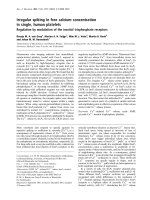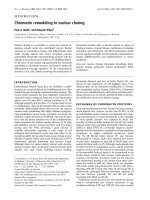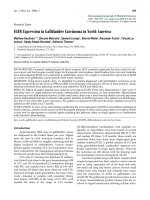Báo cáo y học: "onsidering comorbidity in managing rheumatic diseases: going where trials cannot go" potx
Bạn đang xem bản rút gọn của tài liệu. Xem và tải ngay bản đầy đủ của tài liệu tại đây (118.16 KB, 2 trang )
It remains a great challenge to treat the complexity of
systemic rheumatic diseases in clinical practice. In
contrast to what one may think, these challenges are not
so much related to a lack of eff ective treatments, as many
powerful drugs are available for treating rheumatoid
arthritis, many of which became licensed over the course
of the past decade [1]. e use of any of these new - as
well as of the ‘older’ - drugs is scientifi cally based on
results of randomized controlled trials. e classical
design of these trials, however, is what makes the step
into clinical practice so challenging. With the strict
inclusion and exclusion criteria of these trials, the patient
populations tested in those trials are in sharp contrast to
patients requiring treatment in clinical practice. is is
further supported by the fact that only a fraction of
patients in a rheumatology practice would fulfi ll the
criteria to enter phase II/III trials [2]. A central reason for
this is that patients with potential risk factors for an
adverse reaction to an investigative drug are excluded
from the beginning to make the trial safer; but this group
of patients constitutes a large portion of those who will
ultimately require treatment in clinical practice. Until the
recent calls for more pragmatic trials [3] that address
patient populations with all the risk factors faced in daily
practice have manifested in actual trial designs, physi-
cians will often need to make their own decisions,
weighing expected (but sometimes unknown) risks
against the possible benefi ts.
Although a number of management guidelines for
diff erent rheumatic diseases, such as those by the
European League Against Rheumatism (EULAR) or the
American College of Rheumatology (ACR), are in the
public domain, the guidance is inherently vague when it
comes to the many diff erent challenges of dealing with
comorbid conditions in rheumatic diseases. e main
concerns here are safety issues associated with treatments,
such as in the case of nonsteroidal anti-infl ammatory
drug (NSAID) treatment in patients with liver or
cardiovascular disease, but in theory one could also think
about potential synergisms of treating the index disease
and a comorbid condition at the same time- for example,
when treating arthritis patients with concomitant
infl ammatory bowel disease.
e purpose of this new series of reviews in Arthritis
Research and erapy is to comprehensively provide an
update on these issues, including new developments and
current perspectives on rheumatic patients who present
with a comorbid condition. Each review of this series
therefore addresses a diff erent organ or organ system. We
are very grateful that experts specialized in rheumatology
together with experts from other specialties have contri-
buted to this series by reviewing the currently available
literature combined with their expertise. Specifi cally, the
series will provide a very broad perspective on distinct
and frequent organ manifestations provided by experi-
enced rheumatologists as well as pulmologists, nephro lo-
gists, oncologists, hematologists, infecti ous diseases
special ists, and hepatologists, respectively, in each review.
e lack of clear recommendations on how to manage
most of the comorbid situations, but also the diffi culty of
fi nding important data from cohort studies and registries,
which are usually reported less prominently than clinical
trials, are a major motivation for this series. e fi rst of
these reviews, which is published in the current issue of
Arthritis Research and erapy on ‘Treating rheu matic
patients with a malignancy’ [4], is exemplary in support-
ing this motivation: malignancy, even ‘just’ by history, is a
major challenge in real life, as many of the drugs used to
treat rheumatic diseases are immunosuppressives, and as
such are often claimed to increase the risk of malignancy,
even in otherwise healthy individuals.
We hope that the reviews from the current comorbidity
series will provide a comprehensive and up-to-date over-
view. Each review will allow the reader to gain a
comprehensive look at the respective clinical question,
and hopefully help to facilitate daily decisions in clinical
practice. At the same time, academic centers are working
on the research agenda to identify and fi ll gaps in the
evidence on how to manage comorbidities in certain
rheumatic diseases. Although these reviews do not
© 2010 BioMed Central Ltd
Considering comorbidity in managing rheumatic
diseases: going where trials cannot go
Daniel Aletaha* and Thomas Dörner
EDITORIAL
*Correspondence:
Division of Rheumatology, Division of Internal Medicine 3, Medical University
Vienna, Waehringer Guertel 18-20, 1090 Vienna, Austria
Aletaha and Dörner Arthritis Research & Therapy 2011, 13:116
/>© 2011 BioMed Central Ltd
con sti tute guidelines or recommendations, the current
per spec tives of specialists may promote what we are all
striving for, optimal care in rheumatology.
Competing interests
The authors declare that they have no competing interests.
Published: 29 June 2011
References
1. Smolen JS, Aletaha D, Koeller M, Weisman MH, Emery P: New therapies for
treatment of rheumatoid arthritis. Lancet 2007, 370:1861-1874.
2. Zink A, Askling J, Dixon WG, Klareskog L, Silman AJ, Symmons DP: European
biologicals registers: methodology, selected results and perspectives. Ann
Rheum Dis 2009, 68:1240-1246.
3. Boers M: A call for pragmatic treatment trials in rheumatoid arthritis. Nat
Clin Pract Rheumatol 2008, 4:292-293.
4. Elandt K, Aletaha D: Treating rheumatic patients with a malignancy. Arthritis
Res Ther 2011, 13:223.
doi:10.1186/ar3354
Cite this article as: Aletaha D, Dörner T: Considering comorbidity in
managing rheumatic diseases: going where trials cannot go. Arthritis
Research & Therapy 2011, 13:116.
This article is part of the series Comorbid conditions in subjects with
rheumatic diseases, edited by Daniel Aletaha and Thomas Dörner.
Other articles in this series can be found at
/>Aletaha and Dörner Arthritis Research & Therapy 2011, 13:116
/>Page 2 of 2









